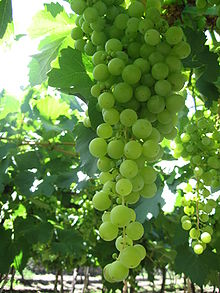Argentine wine is usually colored red, as in Malbec and Cabernet Sauvignon. In Argentina, a glass of red wine is just the thing to enjoy with the country's famous asado, a sizzling slab of grilled beef.
 |
| A contented red angus |
In fact, Argentina is the number-one consumer of beef in the world, putting away an impressive 160 pounds per inhabitant, compared to the U.S. per capita of 84 pounds. Australian beef lovers are just behind Americans. And in second place? Zimbabwe!
It takes a lot of Malbec to wash down that amount of asado, so you have to wonder if Argentina makes white wine. It does. And Argentine white wines are growing in popularity as more Argentinians turn to lighter food. Beef ranchers are beginning to feel the pinch, with the lighter movement forcing the domestic sale of red meat to trend down.
Most U.S. wine shops have rows of Argentine Malbec, but what about white wine? Let's take a closer look at what styles of white wine are in stock.
At the top of the Argentina list, mainly because it's so pervasive, is Chardonnay. Followers of my writing, are aware of my indifference toward Chardonnay. To be clear, I don't dislike Chardonnay, but find there are so many more interesting white wines, like Riesling, Albariño, Semillon, that show pure fruit flavors not hidden under gobs of new French oak.
Fortunately, Argentine winemakers, like their colleagues around the world, have heard consumer complaints about too much oak in Chardonnay, especially new French oak. Winemakers in Mendoza and San Juan have been focusing on the essential flavors in Chardonnay and how to best integrate those flavors with the moderate influence of oak.
Torrontés. Virtually unknown in the United States, Torrentés is the white grape with the most potential. And with the proper marketing, Torrontes promises to do for Argentine white wine what Malbec has done for Argentine red wine.
My first taste of Torrontés was in Argentina. The local buzz in Mendoza, then and now, was about the winemaker, Susana Balbo, who had been crowned the "Queen of Torrontés." Unique
to Argentina, Torrontés is a dry, fruity wine, with bright nectarine
flavors, highlighted by floral and citrus zest notes. The Balbo Torrentés I had in Mendoza hit all those notes.
Balbo Torrontés available at U.S. retail, include Susana Balbo Signature Barrel Fermented Torrentés, $30 and Signature Brioso White Blend, of Torrontés, Sauvignon Blanc and Semillon, $25. Balbo also has Crios de Susana Balbo Torrontés, $19, a tribute to her children; "crios" is Spanish for "kids."
There are three varieties of Torrontés in Argentina: Torrontés-Riojano, Torrontés-Sanjuanino, mainly grown in San Juan province; and Torrontés-Mendocino, also common in San Juan province.
Torrontés Riojano is the most common variety and is the second-most planted white wine grape in Argentina. Riojano is a cross of Muscat Alexandria and Criolla Chica, known in California as the historic Mission grape.
An aside. Regulations for the production of wine and grape growing vary from country to country. The United States has a range of rules, including the AVA system, but by and large, American wineries can grow what grapes they wish and make the type of wine they want. Apparently, the system is quite different in Argentina.
In its September issue, Decanter magazine reported that Argentina's government entity responsible for the regulation of wine production and grape growing, has approved the Criolla Chica grape for the production of light red wine. It would seem that in the past, Argentine wineries were only officially permitted to use the Criolla Chica grape for rosé wines and in blends.
The literal translation of "criolla chica" is "creole girl," and that makes me wonder why anyone would give that name to a wine grape?
With the new ruling on Criolla Chica, it's now likely that we will see more Argentine white wines and light reds. Proprietary blends are popular, such as the unusual combination of Chardonnay and Sauvignon Blanc. Until recently, Chardonnay was the only white that was rarely blended with another variety.
There
are four varieties of Torrontés in Spain, none of them the same as the
three in Argentina. The Spanish Torrontés I had was lighter and a little lower in acidity, with a flavor profile closer to Albariño.
All wine regions have a signature wine; Argentina has two: Torrontés and Malbec. Next time you reach for an Argentine wine, make it Torrontés, priced reasonably between $12 and $19, with the odd one, like the Balbo barrel-fermented, at a higher price.
Next post: My Favorite Wine
To leave a comment, without signing in to Google, go to boydvino707@gmail.com




No comments:
Post a Comment
Note: Only a member of this blog may post a comment.